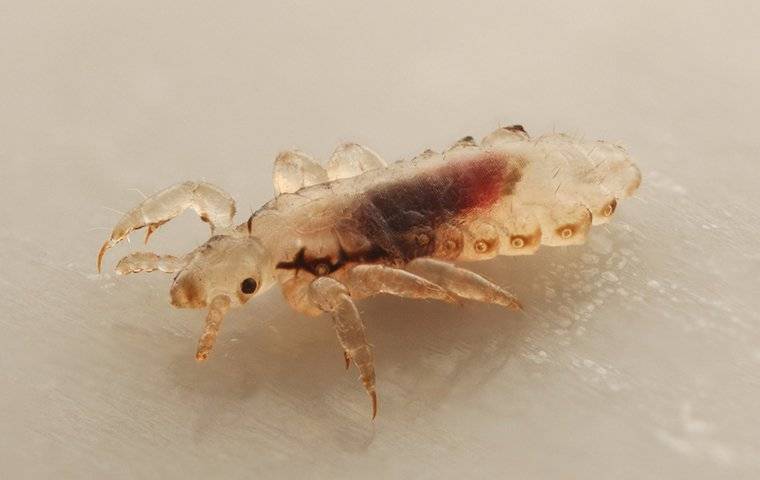
Lice
Natural Characteristics Of Lice
The head lice in North Carolina, Pediculus capital, is one of three types of lice that plague people. The other two are Pediculus humanus, the body or dress lice, and Pthirus pubis, the pubic or “crab” lice. Body lice are related to poor cleanliness, have given all lice terrible notoriety. Body lice live on garments and go to the body just to sustain. In this manner, they are most regularly found among displaced people, casualties of disasters or war and people who can’t wash or change clothes.

Head lice, conversely, spend their whole lives on the human scalp, sticking to the hair while bolstering, mating, and laying eggs. They are not connected to poor living conditions and are most ordinarily found in people with great cleanliness.
Description
What They Look Like
Grey-white bugs the size of a sesame seed. Nits (lice eggs, which are more commonly seen than full-grown adults) appear as yellow, tan, or brown dots.
Typical Location
All over the world. Lice usually hang out on the scalp, although some varieties can infest the rest of the body.
Favorite Snacks
Human and animal blood.
Danger Zone
Itching, insomnia, and infected sores due to itching are the worst side effects.
The Lifecycle Of Head Lice
Twenty-four hours in the wake of mating, the female head lice lay her eggs, more commonly referred to as a nit. Under ideal conditions, a solid female lays around 140 eggs amid her lifetime of around 30 days. The eggs are covered with a fixative that concretes them to the hair shaft. Since the synthetic structure of this fixative substance is fundamentally the same as that of the hair shaft, scientists still can’t seem to build up an item that will break down the fixative without harming the hair. In the same way as other ectoparasites (outer parasites) that can persist starvation and extremes of temperature, lice, and their eggs can survive just under moderately limit set of natural conditions.
From their first blood supper to their last, head lice need to nourish each four to six hours and will die if they don’t do so. In this manner, in spite of the fact that lice may fall or climb onto different surfaces, it can’t live on these and must come back to a human head inside 24 hours on the off chance that it is to survive.
Lice Treatment Tips & Techniques – Lice Control
Many school authorities demand a no-nit arrangement to guarantee the opportunity from invasion and verification of sufficient treatment. Since this strategy neglects to separate amongst feasible and non-reasonable nits, it has a tendency to incorporate youngsters who represent no risk of transmitting head lice from going to class.
The no-nit approach additionally puts a significant weight on guardians, who must experience the tedious procedure of expelling all nits from the hair. For some working guardians, this incorporates requiring some serious energy off from work.
Lather, rinse, repeat. The best (and most environmentally-friendly) way to ditch lice is by washing all clothes in hot water and soap. Use tea tree oil shampoo and then follow with a rinse made with equal parts vinegar and water. Use a special nit comb to go through the hair and remove nits. Sprinkle an essential oil like peppermint or tea tree on the comb before and after combing.
Customer Reviews
-
“He spent time educating us about "pests" and provided information regarding services with GoForth.”- Joyce C.
-
“Texted me before coming. Worked with me playing musical rooms with my dogs. I'll see how things are.”- Constance E.
-
“Amazing response time, reasonable prices, great customer service. Tevin was thorough and confident in his plan to fix our horrendous fire ant problem. We have had negative experiences with prior exterminators and probably waited way too long to call Go-For”- Ashley T.
-
“- Toya B.
We have been customers for almost 7 years for a reason. Our technician is the best. He always knows exactly how to address whatever pest has decided to bother us. We have referred them to many of our neighbors. Well worth the cost not to have to worry a
” -
“Answered all my questions and I felt their pricing was very reasonable.”- Deborah J.
-
“Brian went above and beyond what was expected, and I hope I get him again as my technician for future services!”- Tam L.
-
“He was thorough with inspecting and treating our home, which I really appreciate, and he took the time to answer my many questions.”- Jasmine B.
-
“Love the detailed summary and pics of what he did and saw! And did I mention how wonderful Olivia was to get us all set up?!!”- Beechy A.


Why Choose Go-Forth Home Services?
-
The Best & Highest ReviewsBBB A+ Rated and 4.8 or higher on Google and Facebook for the highest rated local company in the Triad.
-
Seven North Carolina Technicians of the YearHome of the 2009, 2010, 2012, 2013, 2014, 2015, & 2016 statewide technicians of the year.
-
A+ Rating with Better Business BureauBBB Accredited since 1973 for 48 years of continuous accreditation.
-
Serving North Carolina, South Carolina, Georgia, & Virginia
With six locations and dozens of technicians in the field every day, we service areas of North & South Carolina, Georgia, and Virginia.
-
Residential & Commercial ServiceResidential and commercial clients in Greensboro, NC and beyond can attest - Go-Forth provides only the very best in home services.
-
4.9 Star Google Review Rating Across Three StatesGo-Forth Home Services is proud to have thousands of Google reviews with an average rating of 4.9 stars!